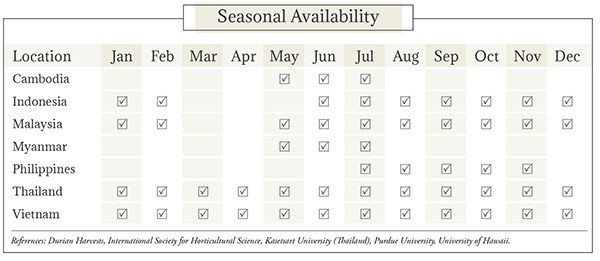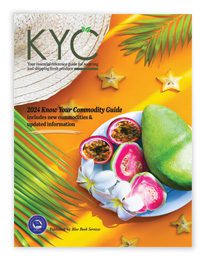Durian Market Summary


Image: tristan tan/Shutterstock.com
Durian Market Overview
Durian (Durio zibethinus) was given its Latin name by Carl Linnaeus, the famed “father of taxonomy” in 1741, based on written descriptions of the fruit and tree. The common name for the fruit, durian, is drawn from the Malay word for thorn, referring to the fruit’s husk. Called “the king of fruits” or the “heaven and hell fruit” (due to its desirable taste and undesirable smell), durian is banned in some public spaces due to its pungent scent. Despite its smell, the fruit is widely grown commercially and for subsistence across Southeast Asia, primarily in Cambodia, Indonesia, Malaysia, Myanmar, Thailand, Vietnam, and the Philippines. Durian is generally large and ovular, featuring a hard green to brownish thorn-covered husk. Ripe fruit can weigh up to 8 pounds and measure up to 20 centimeters in diameter. The inside of the fruit is broken up into five or six segments with a large seed (about the size of a chestnut) surrounded by a soft, meaty pulp or arils. Both the pulp and seed can be eaten. Durian is perhaps best known for its distinctive aroma and soft, sweet, custardy flesh. It is most often eaten fresh, but can also be processed or frozen to extend postharvest shelf-life. The fruit can be found in everything from savory dishes and curries to sweet puddings, and is widely relished for its rich, creamy flavor.
Types & Varieties of Durian
A significant number of varieties and cultivars exist, with hundreds of registered cultivars on the books at the Thai Ministry of Agriculture. Varieties encompass many differences from size of the fruit and seed to smell and sweetness of the flesh. A sampling includes Bawor, Matahari, Othong, Petruk, and Sunan from Indonesia; Golden Phoenix, Green Bamboo, Musang King, Red Prawn, and Sultan in Malaysia; Alcon Fancy, Arancillo, Duyaya, and GD-69 in the Philippines; and Chanee, Ganyao, Kan Yau, Moonthong (Golden Pillow), and Puangmanee in Thailand. Thailand is the largest exporter of durian with Moonthong being the most popular, with a less pungent smell with a sweet, creamy flesh. Hawaii grows two varieties, Kilauea and Pohokalani, based on imported Thai cultivars.Cultivation of Durian
Durian grows well in ultra-tropical, humid environments. Suitable soils will be well-drained with a pH between 5 and 7.5. Durian trees do not do well when exposed to drying winds or in locations with frequent drought. Preferred humidity is between 70 and 85% with an average daytime temperature of 85°F. Although durian grows best with consistent rainfall, flowering requires less moisture. Trees are often grafted between 6 months and a year and should have ample space to grow. Due to their height, trees are often topped at 25 to 40 feet. Branches are generally supported by bamboo or ropes to help hold heavy fruit. Durian is typically harvested once ripe (though unripe durian is consumed in some parts of Southeast Asia). Ripeness can be tested by tapping the fruit for a dull hollow sound. Ripe fruit will fall from trees on their own, yet this can cause damage and shorten shelf life.


